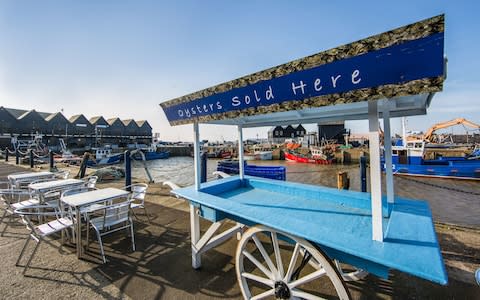Why you should spend a weekend in Whitstable – England's oyster capital
If you like oysters, you’ll love Whitstable, at least for the time being. A medium-sized seaside town on the north Kent coast, Whitstable goes with oysters like a bivalve goes with a rock.
It’s been harvesting them for centuries, has its annual oyster festival this weekend, and is the kind of place where it’s harder to avoid an oyster than eat one. We’re one name-change (Oysteropolis? Shellbyville?) away from Hamburg and Frankfurt-level food synonymity.
Such, at any rate, is the argument made by Whitstable Oyster Fishery Company (WOFC), which has been told by the council to remove the beach-mounted trestles on which it cultivates shellfish. Critics say the trestles are hazardous to beachgoers and an eyesore; WOFC says it’s Nimbyism and that getting rid of the trestles, which it expects to yield 100 tons of oysters this year, could cost 200 jobs.

The festival (which gives centre stage to the larger rock oyster, available all year round, though Whitstable is also famous for its smaller natives) won’t be affected, but WOFC has been ordered to remove all of its oyster paraphernalia from its stretch of Whitstable Beach by Oct 17. The company will still be able to seed oysters on the seabed, but says this will be much less efficient than using the trestles.
In order to figure out whether Canterbury City Council has thrown away a pearl richer than all its tribe, I embarked on a fact-finding jolly last Thursday.
We parked by the harbour. A salty honk of seafood assailed our noses: on a clear day, you can presumably see the cartoon stink lines emanating from the black clapboard huts that are still used by the oyster trade.

But this wasn’t a clear day; it was a grey Thursday lunchtime. There weren’t many people around. Instead, there were hardy-looking fishing boats, a monochrome sky, a single, wheeling seagull and a corrugated metal-clad asphalt plant across the harbour. It felt like the kind of place at which you’d make your final fuel stop before chugging off for a doomed mission across Antarctica.
Around the corner, it was more cheerful. Three rows of black clapboard huts comprise Whitstable Harbour Market, offering hot food, marine art, ironwork and driftwood curiosities. What they lack in harpoons, they make up for in beachgoing gear. Huts, sheds and other structures sell oysters, whelks and similar.
Who needs the Grand Canyon? Britain's answers to the wonders of the world
The town beyond the harbour is pretty humdrum and un-seasidey in some places; in others, such as Harbour Street, it’s chichi and colourful. Harbour Street has the pastel-painted wooden shopfronts you’d expect from a well-to-do British coastal town – if you shopped here, pottered around on Tankerton Beach and poked your head around the door of the museum, you’d have a nice enough time in Whitstable – even without the oysters.
Daytripper | More from our series on UK days out
Six fine reasons to visit Whitstable
The gardens
Whitstable Castle, which has only been around for a couple of hundred years and as such is more of a wedding venue than a site of great historical interest, is surrounded by pretty, well-managed gardens. Free entry.
The beach
To the west of the harbour is Tankerton Beach, a long stretch of shingle overlooked by colourful beach huts.

The oysters
Confession: The Daily Telegraph neither had the time (nor the will) to try every single oyster restaurant in town. Wheelers Oyster Bar, however, is an old local favourite.
The museum
The Tardis-like Whitstable Museum and Gallery tells a genuinely interesting local history – a low bar, but one that other seaside museums often fail spectacularly to clear – that includes the invention of underwater diving gear.

The trail
The seven-mile Oyster Bay trail runs from Swalecliffe just outside town to Reculver, where a ruined chapel sits atop a Roman fort and the Isle of Thanet begins – with sea views all the way.
The market
Lots of nice stuff to buy, eat and drink at the Harbour Market.
Win a luxury holiday worth up to £80,000
